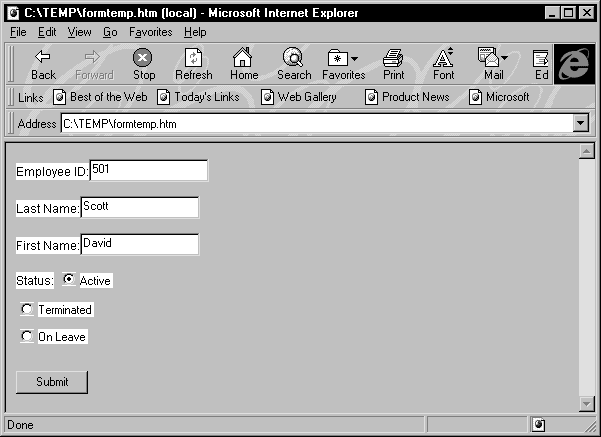The GenerateHTMLForm method creates HTML form syntax for DataWindow objects. You can create an HTML form that displays a specified number of columns for a specified number of rows. Note the following:
You create HTML form syntax by calling the GenerateHTMLForm method for the DataWindow control or DataStore
The GenerateHTMLForm method creates HTML form syntax for the detail band only
Embedded nested DataWindows are ignored; they are omitted from the generated HTML
Although the GenerateHTMLForm method generates syntax for all presentation styles, the only styles that create usable forms are Freeform and Tabular.
The following HTML page shows a freeform DataWindow object converted into a form using syntax generated by the GenerateHTMLForm method:

The GenerateHTMLForm method converts column edit styles into the appropriate HTML elements:
Column edit style |
HTML element |
|---|---|
CheckBox |
Input element specifying TYPE=CHECKBOX |
DropDownDataWindow |
Select element with a single Option element |
DropDownListBox |
Select element with one Option element for each item in the DropDownListBox |
Edit |
Input element specifying TYPE=TEXT |
RadioButton |
Input element specifying TYPE=RADIO |
To generate HTML form syntax, you call the GenerateHTMLForm method:
instancename.GenerateHTMLForm ( syntax, style, action { , startrow, endrow, startcolumn, endcolumn { , buffer } } )
The method places the Form element syntax into the syntax argument and the HTML style sheet into the style argument, both of which are passed by reference.
![]() Static texts in freeform DataWindow objects
All static texts in the detail band are passed through to
the generated HTML form syntax. If you limit the number of columns
to be converted using the startcolumn and endcolumn arguments,
remove the headers from the detail band for the columns you eliminate.
Static texts in freeform DataWindow objects
All static texts in the detail band are passed through to
the generated HTML form syntax. If you limit the number of columns
to be converted using the startcolumn and endcolumn arguments,
remove the headers from the detail band for the columns you eliminate.
Here is an example of the GenerateHTMLForm method:
String ls_syntax, ls_style, ls_action
String ls_html
Integer li_return
ls_action = &
"/cgi-bin/pbcgi60.exe/myapp/uo_webtest/f_emplist"
li_return = ds_1.GenerateHTMLForm &
(ls_syntax, ls_style, ls_action)
IF li_return = -1 THEN
MessageBox("HTML", "GenerateHTMLForm failed")
ELSE
// of_MakeHTMLPage is an object method,
// described in the next section.
ls_html = this.of_MakeHTMLPage &
(ls_syntax, ls_style)
END IF
After calling the GenerateHTMLForm method, the ls_syntax variable contains a Form element. Here is an example:
<FORM ACTION=
"/cgi-bin/pbcgi60.exe/myapp/uo_webtest/f_emplist"
METHOD=POST>
<P>
<P><FONT CLASS=2>Employee ID:</FONT>
<INPUT TYPE=TEXT NAME="emp_id_1" VALUE="501">
<P><FONT CLASS=2>Last Name:</FONT>
<INPUT TYPE=TEXT NAME="emp_lname_1" MAXLENGTH=20 VALUE="Scott">
<P><FONT CLASS=2>First Name:</FONT>
<INPUT TYPE=TEXT NAME="emp_fname_1" MAXLENGTH=20 VALUE="David">
<P><FONT CLASS=2>Status:</FONT>
<INPUT TYPE="RADIO" NAME="status_1" CHECKED CLASS=5 ><FONT CLASS=5 >Active
<P>
<INPUT TYPE="RADIO" NAME="status_1" CLASS=5 >
<FONT CLASS=5 >Terminated
<P>
<INPUT TYPE="RADIO" NAME="status_1" CLASS=5 >
<FONT CLASS=5 >On Leave
<P>
<P>
<BR>
<INPUT TYPE=SUBMIT NAME=SAMPLE VALUE="OK">
</FORM>
The ls_stylesheet variable from the previous example contains a Style element, an example of which is shown below:
<STYLE TYPE="text/css">
<!--
.2{COLOR:#000000;BACKGROUND:#ffffff;FONT-STYLE:normal;FONT-WEIGHT:normal;FONT:9pt "Arial", sans-serif;TEXT-DECORATION:none}
.3{COLOR:#000000;BACKGROUND:#ffffff;FONT-STYLE:normal;FONT-WEIGHT:normal;FONT:8pt "MS Sans Serif", sans-serif;TEXT-DECORATION:none}
.5{COLOR:#000000;BACKGROUND:#ffffff;FONT-STYLE:normal;FONT-WEIGHT:normal;FONT:8pt "MS Sans Serif", sans-serif;TEXT-DECORATION:none}
-->
</STYLE>
![]() Unique element names
The GenerateHTMLForm method creates unique names for all elements
in the form (even when displaying multiple rows in one form) by
adding a _nextsequentialnumber suffix.
Unique element names
The GenerateHTMLForm method creates unique names for all elements
in the form (even when displaying multiple rows in one form) by
adding a _nextsequentialnumber suffix.
To use the syntax and style sheet returned by the GenerateHTMLForm method, you must write code to merge them into an HTML page. A complete HTML page requires <HTML> and <BODY> elements to contain the style sheet and syntax.
One way to do this is to create a global or object function that returns a complete HTML page, taking as arguments the Form and Style elements generated by the GenerateHTMLForm method. Such a function might contain the following code:
// Function Name: of_MakeHTMLPage
// Arguments: String as_syntax, String as_style
// Returns: String
//***********************************
String ls_html
IF as_syntax = "" THEN
RETURN ""
END IF
IF as_style = "" THEN
RETURN ""
END IF
ls_html = "<HTML>"
ls_html += as_style
ls_html += "<BODY>"
ls_html += "<H1>Employee Information</H1>"
ls_html += as_syntax
ls_html += "</BODY></HTML>"
RETURN ls_html